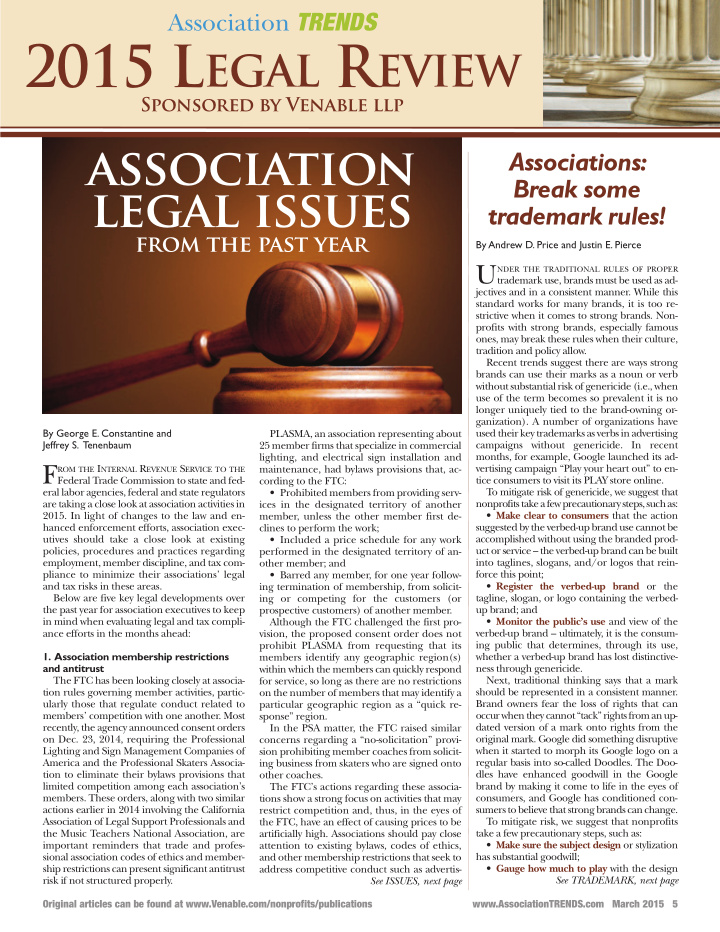



Association TRENDS 2015 L EGAL R EVIEW Sponsored by Venable llp association Associations: Break some legal issues trademark rules! from the past year By Andrew D. Price and Justin E. Pierce U nder the trAditionAl rUles of proper trademark use, brands must be used as ad- jectives and in a consistent manner. While this standard works for many brands, it is too re- strictive when it comes to strong brands. non- profits with strong brands, especially famous ones, may break these rules when their culture, tradition and policy allow. recent trends suggest there are ways strong brands can use their marks as a noun or verb without substantial risk of genericide (i.e., when use of the term becomes so prevalent it is no longer uniquely tied to the brand-owning or- ganization). A number of organizations have plAsMA, an association representing about used their key trademarks as verbs in advertising By George E. Constantine and 25 member firms that specialize in commercial campaigns without genericide. in recent Jeffrey S. Tenenbaum lighting, and electrical sign installation and months, for example, Google launched its ad- f roM the i nternAl r evenUe s erviCe to the maintenance, had bylaws provisions that, ac- vertising campaign “play your heart out” to en- federal trade Commission to state and fed- cording to the ftC: tice consumers to visit its plAY store online. eral labor agencies, federal and state regulators • prohibited members from providing serv- to mitigate risk of genericide, we suggest that are taking a close look at association activities in ices in the designated territory of another nonprofits take a few precautionary steps, such as: 2015. in light of changes to the law and en- member, unless the other member first de- • Make clear to consumers that the action hanced enforcement efforts, association exec- clines to perform the work; suggested by the verbed-up brand use cannot be utives should take a close look at existing • included a price schedule for any work accomplished without using the branded prod- policies, procedures and practices regarding performed in the designated territory of an- uct or service – the verbed-up brand can be built employment, member discipline, and tax com- other member; and into taglines, slogans, and/or logos that rein- pliance to minimize their associations’ legal • Barred any member, for one year follow- force this point; and tax risks in these areas. ing termination of membership, from solicit- • Register the verbed-up brand or the Below are five key legal developments over ing or competing for the customers (or tagline, slogan, or logo containing the verbed- the past year for association executives to keep prospective customers) of another member. up brand; and in mind when evaluating legal and tax compli- Although the ftC challenged the first pro- • Monitor the public’s use and view of the ance efforts in the months ahead: vision, the proposed consent order does not verbed-up brand – ultimately, it is the consum- prohibit plAsMA from requesting that its ing public that determines, through its use, members identify any geographic region(s) whether a verbed-up brand has lost distinctive- 1. Association membership restrictions within which the members can quickly respond ness through genericide. and antitrust the ftC has been looking closely at associa- for service, so long as there are no restrictions next, traditional thinking says that a mark tion rules governing member activities, partic- on the number of members that may identify a should be represented in a consistent manner. ularly those that regulate conduct related to particular geographic region as a “quick re- Brand owners fear the loss of rights that can members’ competition with one another. Most sponse” region. occur when they cannot “tack” rights from an up- recently, the agency announced consent orders in the psA matter, the ftC raised similar dated version of a mark onto rights from the on dec. 23, 2014, requiring the professional concerns regarding a “no-solicitation” provi- original mark. Google did something disruptive lighting and sign Management Companies of sion prohibiting member coaches from solicit- when it started to morph its Google logo on a America and the professional skaters Associa- ing business from skaters who are signed onto regular basis into so-called doodles. the doo- tion to eliminate their bylaws provisions that other coaches. dles have enhanced goodwill in the Google limited competition among each association’s the ftC’s actions regarding these associa- brand by making it come to life in the eyes of members. these orders, along with two similar tions show a strong focus on activities that may consumers, and Google has conditioned con- actions earlier in 2014 involving the California restrict competition and, thus, in the eyes of sumers to believe that strong brands can change. Association of legal support professionals and the ftC, have an effect of causing prices to be to mitigate risk, we suggest that nonprofits the Music teachers national Association, are artificially high. Associations should pay close take a few precautionary steps, such as: important reminders that trade and profes- attention to existing bylaws, codes of ethics, • Make sure the subject design or stylization sional association codes of ethics and member- and other membership restrictions that seek to has substantial goodwill; ship restrictions can present significant antitrust address competitive conduct such as advertis- • Gauge how much to play with the design risk if not structured properly. See TRADEMARK, next page See ISSUES, next page Original articles can be found at www.Venable.com/nonprofits/publications www.AssociationTRENDS.com March 2015 5
Recommend
More recommend